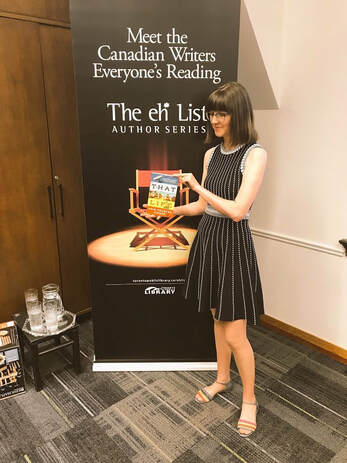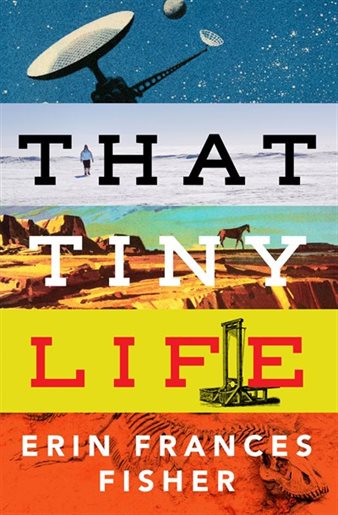 That Tiny Life, Erin Frances Fisher's recent collection of five stories and a novella, is just so good (at left, Erin deservedly has it in the director's chair at a Toronto reading). I find the book's brilliance hard to categorize or analyze, as my questions below probably show, although it camped out in my head for weeks after I finished it. The stories have extremely varied settings and characters, but as Erin notes, they're all built around "hope and desperation." (Thanks to Erin for summarizing that, by the way.) My own answer is that these stories all feel mysterious but entirely complete, an unusual quality in contemporary fiction. Short fiction is my first love. I read a lot of it, and these pieces are standouts for their structure and voice as well as the breadth all the reviews mention. Erin's writing will run along evenly for a page, then you get the punch of startling, exact detail like "petals the size of fingers" or "Your small hips, the red compression lines from your corset." Erin's work has appeared in such journals as Granta and Little Fiction. She teaches at the Victoria Conservatory of Music here in BC. We'll both be at the Galiano Literary Festival next month, and I'm looking forward to hearing a reading in her own voice . 1. The blurbs for your book all mention the huge range of the stories, from Revolution-era France to a future on one of Saturn's moons. Did any of the settings come easier than the others? They were all interesting to write, but yes some settings were easier to find a way into than others. My family spent a few years in Inuvik, NWT, so I have some memories and stories from the north, and my sister is a falconer. The most time-consuming setting was revolutionary Paris. Although almost all Paris’s streets and museums are available virtually, the smaller details were difficult. Like when it rains, who would use an umbrella? And then, were umbrellas even invented? (The answer is yes, waxed parasols, and the wealthier merchant class.) I spent most of the summer in the university library reading through the history of harpsichords and fortepianos. 2. That Tiny Life is the Saturn story title. How did you decide it would be the collection title too? The title of the collection came before the title of the story, and it was actually my wonderful editor, Janie Yoon, who suggested we use it for both. Finding a title for the collection was difficult! Although there’s a thematic connection in the stories, they have very different narrators and settings. The collection needed a title that connected the stories, and “That Tiny Life” expressed the hope and desperation that the stories circle. 3. The White, a novella about a group of damaged people on a farm, is written in different third-person perspectives. The other stories all use first person. Can you talk about how the difference in voice felt to you? The White actually started out in first-person. I wrote a series of monologues in an attempt find a character to narrate, but I couldn’t narrow it down. The shifting point-of-view emphasized misunderstandings, and allowed for varying descriptions of setting, so I decided to keep all five narrators. I switched the point of view over to third person for smoother transitions, and because—after much revision—I found it worked better. Other stories in the collection started in different POVs as well: different narrators, or in third rather than first-person. 4. There's a sense of people trying very hard to reach each other, and not just in "Da Capo al Fine," where the narrator begins with "Cecile, I hope you'll hear what I'm saying." I'm interested in your ideas on connection in the stories. In “Da Capo al Fine” Tobias Schmidt addresses Cecile, repeatedly writing the same letter in order to explain. To me, he’s justifying his actions to himself as much as to Cecile—more even, as he hasn’t listened to her at all. Connection requires at least two people who are open to each other, otherwise it’s something else. So I suppose communication and miscommunication, willful misunderstanding—all that leads to situations that aren’t so great for characters, but are intriguing for the reader. 5. In another connection, animals are a huge part of the book, from a mule in the desert to sled dogs to breeders' falcons. Can you describe the human-animal link here? And what animals might represent? When I’m writing a story I don’t have a theme or symbol in mind, so the animals are firstly just animals. That said, in “That Tiny Life” the narrator’s grandmother breeds Golden Retrievers in a one-room apartment, and I admit choosing a breed that is the epitome of gentle dogs. Large, golden animals that seem friendly without reservation. An idealization of family for the narrator to look back on. 6. There's also money, and the lack of it--the haves and have-nots--a particular focus in "Argentavis Magnificens," where a pair of archaeologists get the funding of their dreams, with strings attached. I'd like to know your thoughts on how that contributes to the book's tension. Money is essential to everyone, and a necessary obstacle in life. Unless a character is in a money-free society then money will be a source of tension. The lack of it, or the overabundance, can cause all sorts of conflict. 7. I've been thinking a lot about music, knowing you're a pianist. The stories and novella all have their own structure, but do you feel that musical structure contributes to any of them? Yes and no? Yes, because music can be mapped the same way stories can be mapped, with rising tension and development through different keys and such. No, because I wouldn’t look at a specific musical structure and build a story around it. Another yes, because music is my job—I spend a lot of time teaching and working on pieces of music. The only intentional music reference is the title “Da Capo al Fine”, which in music means return to the start (literally da capo is “the head”) and play until the end. That story is structured as a letter Tobias Schmidt has written and rewritten many times. You can buy That Tiny Life via your local independent bookstore, Chapters.ca, or Amazon.ca.
1 Comment
|
Storybrain
Alix interviews other writers about their work. Those listed in the Blog will be migrated here sometime! Archives
May 2020
Categories |

 RSS Feed
RSS Feed
